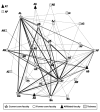Weaving the native web: using social network analysis to demonstrate the value of a minority career development program
- PMID: 21512364
- PMCID: PMC3127457
- DOI: 10.1097/ACM.0b013e318217e824
Weaving the native web: using social network analysis to demonstrate the value of a minority career development program
Abstract
Purpose: American Indian and Alaska Native scientists are consistently among the most underrepresented minority groups in health research. The authors used social network analysis (SNA) to evaluate the Native Investigator Development Program (NIDP), a career development program for junior Native researchers established as a collaboration between the University of Washington and the University of Colorado Denver.
Method: The study focused on 29 trainees and mentors who participated in the NIDP. Data were collected on manuscripts and grant proposals produced by participants from 1998 to 2007. Information on authorship of manuscripts and collaborations on grant applications was used to conduct social network analyses with three measures of centrality and one measure of network reach. Both visual and quantitative analyses were performed.
Results: Participants in the NIDP collaborated on 106 manuscripts and 83 grant applications. Although three highly connected individuals, with critical and central roles in the program, accounted for much of the richness of the network, both current core faculty and "graduates" of the program were heavily involved in collaborations on manuscripts and grants.
Conclusions: This study's innovative application of SNA demonstrates that collaborative relationships can be an important outcome of career development programs for minority investigators and that an analysis of these relationships can provide a more complete assessment of the value of such programs.
Figures


References
-
- Smedley B, Stith A, Nelson A, editors. Unequal Treatment: Confronting Racial and Ethnic Disparities in Health Care. Washington, D.C.: National Academies Press; 2003. - PubMed
-
- Centers for Disease Control and Prevention. Racial disparities in nationally notifiable diseases--United States, 2002. MMWR Morb Mortal Wkly Rep. 2005;54(1):9–11. - PubMed
-
- AAMC files brief supporting University of Michigan admissions. [April 5, 2005];AAMC Reporter. 2003 http://www.aamc.org/newsroom/repo~er/marchO3/umichigan.htm no longer available.
-
- National Institute of Mental Health. Five-year strategic plan for reducing health disparities. Bethesda, MD: National Institute of Mental Health; 2001.
Publication types
MeSH terms
Grants and funding
LinkOut - more resources
Full Text Sources
Research Materials

